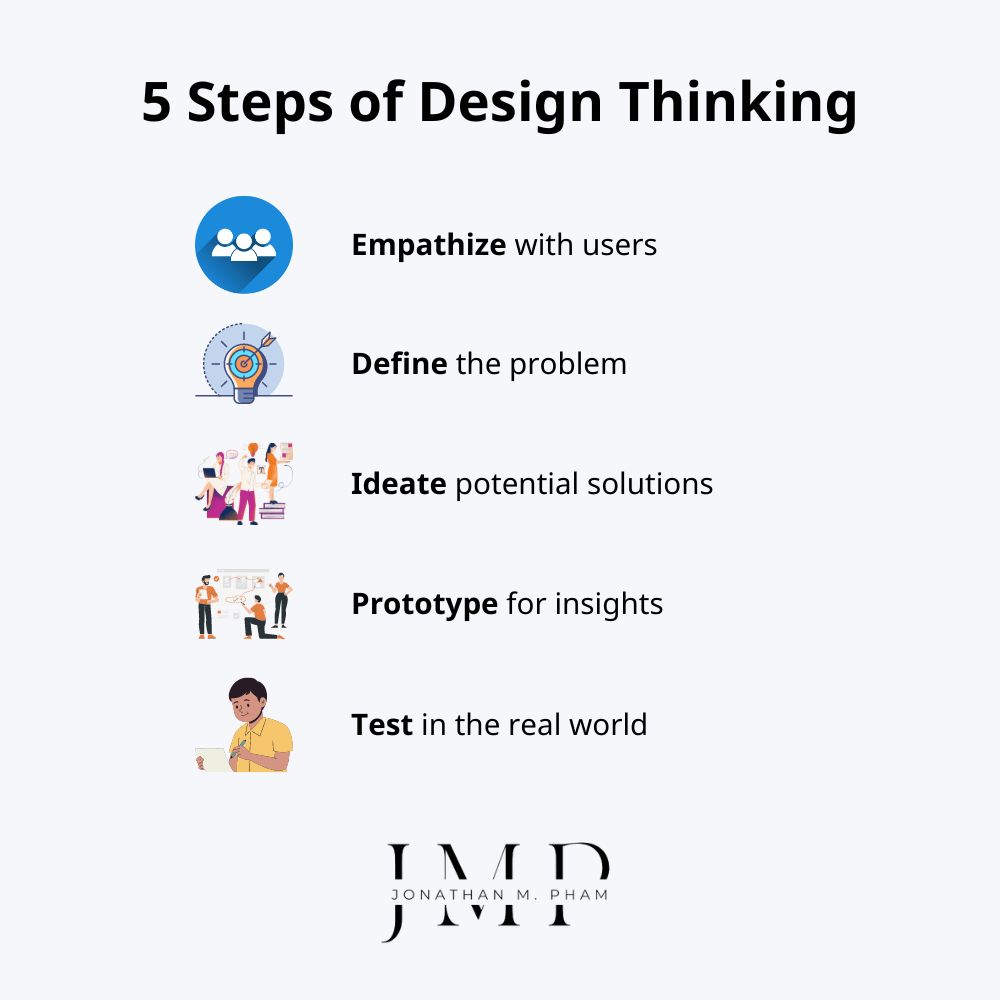Design thinking offers a human-centered approach to problem-solving, helping you break free from old patterns and unlock fresh ideas. Learn how to reframe your thinking and drive innovation with this article!
At first glance, the term ‘design thinking’ might evoke images of artistic endeavors or creative pursuits. However, its application is not confined to the realm of design only – instead, it’s a cornerstone of innovation that can be applied across diverse fields, from literature and art to science, engineering, and business. Understanding the principles of design thinking offers a pathway to harnessing creative, customer-centric problem-solving methods that drive success in today’s dynamic landscape.
Highlights
- Design thinking is a human-centered problem-solving method that emphasizes understanding users, challenging assumptions, and iteratively coming up with innovative solutions. Rooted in design disciplines, the concept emerged in the mid-20th century through scientific analysis of creative problem-solving – and has since then evolved into a user-centered method applicable across various fields.
- Our thinking habits, shaped by previous experiences, are the main factor that hinders innovation capabilities. Design thinking encourages us to break free from these rigid mental patterns – and go beyond surface solutions to uncover root causes and develop user-centered products/ services.
- Design thinkers are known for being human-centered, visually adept, and open to exploring multifaceted solutions through collaboration and creative problem-solving.
- Design thinking tackles challenges through a five-step process of empathizing with users, defining problems, brainstorming solutions, prototyping ideas, and testing them for refinement.
What is Design Thinking?
Design thinking is a powerful problem-solving methodology that goes beyond simply finding solutions. It’s a human-centered approach that emphasizes understanding the needs and perspectives of your target audience.
Core principles:
- Dynamic and iterative: The process of design thinking is not linear – it requires you to constantly gather information, test ideas, solicit feedback, and refine the approach as you move forward.
- User-centric focus: Deep empathy for the user/ target market is crucial. You will need to actively study their needs and motivations to ensure that your products/ services truly address their problems.
- Challenge everything: Don’t accept assumptions at face value. Instead, question existing problems, explore alternative solutions, and redefine issues to find the best method.
- Unlocking innovation: Through a process of constant questioning and exploration, design thinking fosters creativity and lays the foundation for breakthrough ideas.
- Learning by doing: Design thinking is a hands-on approach. It typically involves the use of techniques like sketching and prototyping to create tangible representations of your ideas. This allows for rapid testing and refinement before committing to large-scale solutions.
Origin of Design Thinking
Design thinking begins with skills designers have learned over many decades in their quest to match human needs with available technical resources within the practical constraints of business. By integrating what is desirable from a human point of view with what is technologically feasible and economically viable, designers have been able to create the products we enjoy today.
Tim Brown
Design thinking isn’t a sudden invention; it is a mid-20th-century innovation with roots in established fields like architecture and industrial design. The concept emerged from a growing interest in how designers actually approach problems. Academics and practitioners started dissecting these creative strategies, gradually forming a structured method – what we now refer to as Design Thinking.
The 1950s and 60s were a key period. This era saw a scientific approach to design taking hold, with researchers analyzing everything from a product’s function to the influences on the design process itself. This scientific spirit even led to the coining of the term “Wicked Problems” by theorist Horst Rittel.
Design Thinking, with its core principles of understanding user needs (empathy), teamwork (collaboration), and trying out ideas (experimentation), has been steadily refined over time. It’s no longer confined to the design realm – but has branched out to influence fields like business, technology, and even education.

Importance of Design Thinking
Our cognitive processes are shaped by repeated actions and the accumulation of knowledge over time. While this mechanism enables swift responses in familiar scenarios, it also gives rise to cognitive rigidity, which impedes our capacity to perceive, comprehend, and innovate in novel situations.
This cognitive phenomenon, often termed ‘structural thinking’ or schemas, manifests as organized mental frameworks comprising interconnected information and associations. When confronted with environmental stimuli, these schemas become activated, channeling our thoughts along familiar pathways.
For instance, let’s say you notice a strange fruit at the grocery store. You might pull from your existing knowledge of fruits – round, brightly colored, and having a peel. Based on this schema, you might initially think it’s some kind of apple or citrus. This is an example of how our ingrained cognitive framework works.
However, when confronted with stimuli that deviate from established patterns, our predisposed mental structures may impede objective analysis, hindering our ability to devise fresh problem-solving strategies. In such cases, breaking free from conventional thought patterns becomes imperative for us to unearth innovative, transformative solutions. And that is where the concept of design thinking comes in. Indeed, the fact that it is embraced by industry leaders like Apple, Google, and Samsung – along with prestigious universities like Stanford, Harvard, and MIT – serves as a strong testimony to its broad applicability and effectiveness.
The ‘Design Thinking’ label is not a myth. It is a description of the application of well-tried design process to new challenges and opportunities, used by people from both design and non-design backgrounds.
Bill Moggridge
Design Thinking is About Reframing Our Thought Patterns
Design thinking champions the art of reframing cognitive frameworks to unearth innovative solutions to perplexing problems. Yet, breaking free from conventional thought patterns poses a formidable challenge, as our minds naturally gravitate towards familiar routines and well-trodden paths of thinking.
Imagine you’re a parent struggling to get your child to eat vegetables. You try all the usual tactics – pleading, bargaining, hiding veggies in creative ways – but nothing seems to work. Most of the time, people will just pressure the child to obey – which will only lead to power struggles and cause them to acquire negative associations with foods.
Why is this the case?
It’s because you define the problem as “how to get the child to eat vegetables”. What if you reframe it to “how to make healthy foods more engaging and enjoyable“?
And then you start brainstorming solutions outside the box. Can vegetables be cut into fun shapes? Could there be a reward system based on trying new things, not just finishing everything? Whatever ideas you come up with – e.g. letting the child help prepare the vegetables in a fun way, or creating a chart to track their exploration of new healthy foods – test them out and observe how they respond to the new approach.
Our brains crave efficiency. We build mental shortcuts to navigate daily routines and solve problems quickly. This is great for making toast, but less helpful for complex situations. Experts, especially, can get so comfortable with their established knowledge that questioning it becomes difficult, even when new information emerges.

Benefits of Design Thinking
At its core, design thinking serves as a catalyst for enhancing products/ services by delving into user behaviors and motivations. By encouraging us to embark on a journey of inquiry and exploration into the root causes of problems, it empowers us to generate solutions that authentically address the nuanced facets of the issue at hand.
Below are the 6 main benefits of adopting this transformative approach:
- Multifaceted perspective
Design thinking moves beyond surface-level analysis and encourages considering the problem from various angles – based on the acknowledgment that there are often social, emotional, and technical factors at play. This holistic approach to problem-solving ensures a well-rounded understanding of the issue at hand.
- Root cause analysis
Design thinking doesn’t focus on just treating symptoms; rather, it requires us to delve deeper to uncover the underlying reasons behind a problem. Through techniques such as user interviews and observation, one may identify the true cause, leading to more effective and lasting solutions.
For example, let’s say a library website has been experiencing a high rate of user abandonment during checkout. Rather than doing a quick fix like adding more payment options (addressing the symptom), the administrators may solicit input from the users – after which they find out that the problem has to do with a confusing checkout layout (the root cause). Based on this finding, they move on to redesigning the site’s UI for a smoother experience (a lasting solution).
- Culture of innovation
Design thinking thrives on creative thinking and experimentation. It fosters an environment where people feel comfortable exploring new ideas and taking calculated risks – which is crucial for generating groundbreaking solutions that might not have emerged through traditional methods.
- Customer-centric solutions
At the heart of design thinking is the user. By prioritizing user research and understanding their needs, wants, and frustrations, one may ensure that the final product or service truly resonates with the target audience.
For instance, imagine a company working on a new fitness app focused on weight loss. They might assume that everyone wants calorie counting and intense workouts. However, by conducting user interviews, they might discover a segment desires a focus on healthy meal plans and fun, social workout challenges – which allows them to come up with an app that resonates better with a specific target audience.
- Enriching user experience
Design thinking doesn’t just focus on functionality; it aims to create a positive and memorable experience for the user. This can involve considering the emotional aspects of the interaction and designing products that are not only useful but also enjoyable to use.
- Continuous learning
As an iterative process, design thinking encourages ongoing learning and adaptation based on feedback and testing – so that solutions remain relevant and effective in a constantly evolving environment.
The principles and methodologies of design thinking apply to all echelons of business – they are particularly indispensable for mid-level and senior leadership roles, product/service developers, and those tasked with employee training and mentorship.
Read more: 10x Thinking – Elevate Your Success to New Heights
Characteristics of Design Thinking
Research has indicated that those who embody the essence of design thinking typically exhibit a distinctive set of traits as follows:
- Human-centered: They prioritize understanding and meeting human needs throughout the product or service development process – based on the recognition that user benefits serve as the cornerstone that guides every decision.
- Visual & verbal fluency: Proficient in both visual and verbal communication, design thinkers excel at articulating and illustrating their ideas. They possess a knack for translating abstract concepts into tangible visual representations and articulate explanations.
- Multifaceted approach: They adopt a multifunctional perspective, exploring a plethora of solutions to a given problem while simultaneously balancing the broader context and intricate details. This dual focus is the reason behind their holistic approach to problem-solving.
- Systems thinking: Design thinkers approach problems systemically, analyzing them from diverse angles to uncover comprehensive solutions. They recognize the interconnectedness of various elements and strive for integrated solutions.
- Creative ingenuity: Armed with a mastery of language and inventive thinking, design thinkers serve as catalysts for innovation. They excel at weaving together disparate elements to create novel solutions.
- Collaborative spirit: Design thinkers tend to exhibit strong communication skills and the ability to seamlessly collaborate with people from diverse backgrounds and disciplines.
- Open-minded exploration: Rather than confining themselves to predetermined solutions, they embrace the belief that superior alternatives may yet be undiscovered. As such, they remain open to exploration, tirelessly seeking the most advantageous pathways forward before reaching a final decision.

5 Steps of the Design Thinking Process
While various iterations of the design thinking process exist, they all stem from the foundational principles first articulated by Herbert Simon. In this article, we will delve into the renowned 5-step model developed by the Hasso-Plattner Institute of Design at Stanford University.
Empathize
The Empathize step is the foundation of the process; it’s all about truly understanding the people you’re designing for – their needs, wants, frustrations, and everything in between.
How to empathize:
- Let go of assumptions: We all have biases, which must be set aside in this stage. Listen actively and be open to unexpected insights.
- Immerse yourself: Observe users in their natural environment. See how they interact with similar products or navigate the problem you’re trying to solve.
- Research methods: There are many tools! Conduct interviews, user testing, or surveys. Observe user behavior through shadowing or ethnography studies.
What you’re looking for:
- Needs: What are the user’s essential requirements? What are they struggling with?
- Pain points: What frustrations do they encounter? What aspects of the current situation cause them difficulty?
- Goals & aspirations: What do they ultimately want to achieve? What are their hopes and dreams related to the problem you’re addressing?
By the end of the Empathize step, you should have a rich understanding of your target users – which will become the main fuel of the rest of the design thinking process.
Define
The Define step is about leveraging the user understanding gained in the first phase and turning it into a clear, actionable problem statement – which will become the springboard for brainstorming solutions later.
What it’s about:
- Synthesis: This is where you analyze all the information you gathered previously – by looking for patterns, recurring themes, and areas of pain.
- Problem framing: Turn your user insights into a concise and well-defined problem statement. This statement should focus on the user’s needs, not just the technical aspects of the issue.
How to define the problem:
- User’s perspective: Frame the issue from the user’s point of view. What are they struggling with? How is it impacting their lives?
- Actionable: The problem statement should be clear and specific enough to guide the ideation process.
- Focus on needs: Don’t jump to solutions yet. Focus on what the user needs, not what you think the answer might be.
Tools and techniques:
- Customer personas: Develop a detailed profile of your target users, including their demographics, behaviors, goals, and pain points. This persona serves as a reference throughout the design process.
- Affinity diagramming: Organize user insights into themes and categories to identify underlying patterns.
- Whys: Ask “Why?” repeatedly to dig deeper into the root cause of the problem.
Ideate
With a clear grasp of user needs and defined problem areas, it’s time to unleash creativity and brainstorm alternative solutions! Here’s a closer look at this exciting phase:
What it’s about:
- Quantity over quality: At this stage, the goal is to come up with as many ideas as possible, no matter how crazy they may seem. Don’t judge or filter ideas – rather, aim for a diverse pool of possibilities.
- Building on empathy: Leverage the insights gained from the Empathize step to fuel brainstorming. How can you address the user’s needs in new and innovative ways?
How to ideate:
- Brainstorming techniques: There are many ways to spark creativity – you can consider techniques like brainwriting, mind mapping, or SCAMPER (Substitute, Combine, Adapt, Modify, Put to Other Uses, Eliminate, Rearrange).
- Collaborative environment: Encourage participation from everyone involved. Build on each other’s ideas and foster a safe space for wild thinking.
- Challenge assumptions: Question the status quo and explore unconventional solutions. Don’t be afraid to break away from traditional thinking.
Tips for success:
- Defer judgment: Hold off the tendency to critique ideas. Let the ideas flow freely before evaluating them.
- Visual thinking: Use sketches, drawings, or prototypes to visualize your ideas. These are especially helpful for sparking further creativity and communication.
- Embrace wild ideas: Sometimes it is the most outlandish suggestions that lead to unexpected breakthroughs. As such, don’t censor any ideas at this stage.
Not all ideas will be winners. You will need to evaluate and refine them to figure out the most promising ones to test with the users.
Prototype
The Prototype step in the design thinking process is where you take your ideas from the world of brainstorming and turn them into something real and testable.
What it’s about:
- Learning by doing: Prototypes are low-fidelity, quick-and-dirty versions of your potential solutions. They allow you to see your ideas come to life, test them with users, and gather valuable feedback early on.
- Iterative process: Most of the time, you will have to create multiple prototypes, test them, refine them based on feedback, and repeat the process.
Benefits of prototyping:
- Early input: Get user feedback early and cheaply before investing significant time and resources into a polished product/ service.
- Identify flaws: Prototypes serve to reveal usability issues, design flaws, or areas where your solution might not be meeting user needs.
- Test feasibility: See if your ideas are technically viable and explore different approaches before committing to a final design.
Types of prototypes:
- Low-fidelity: These are quick and simple prototypes, often made from paper, cardboard, or basic digital tools. They focus on core functionalities and user experience.
- Medium-fidelity: More detailed prototypes with higher visual fidelity, allowing for more user interaction and testing of specific features.
- High-fidelity: These closely resemble the final product, with advanced features and a polished look and feel.
Test
The Test phase is where the rubber meets the road. You’ve developed empathy for your audience, defined the problem, brainstormed solutions, and built prototypes. Now it’s time to determine how those prototypes hold up in the real world with real users!
Why testing is crucial:
- Validate assumptions: Your initial ideas may not be what users actually need. Testing is crucial for examining your assumptions and ensuring your solution is on the right track.
- Uncover usability issues: Even the most well-designed prototype might come with usability issues that you haven’t foreseen. Testing helps you identify these problems early on.
- Gather feedback: Users can provide invaluable insights into how your prototype works, what they like and dislike, and how it can be improved.
How to:
- Recruit the right users: Test with those who truly represent your target audience.
- Clearly defined goals: Set specific goals for your testing session. What do you want to learn from the users?
- Observe and ask questions: Don’t just tell people what to do. Watch how they interact with the prototype and ask open-ended questions to gain deeper insights.
- Iterative process: Testing is not a one-time event. Based on the solicited input, you’ll likely need to refine your prototype and test again.
Types of testing:
- Usability testing: This type of testing focuses on how easy and intuitive your prototype is to use.
- A/B testing: Comparing two different versions of your prototype to see which one performs better.
- Guerilla testing: A quick and informal way to get user feedback by testing your prototype with people you encounter in everyday situations.

Tips for design thinking
Design thinking isn’t a one-size-fits-all approach. Variations exist; for example, the Design Council’s Double Diamond (Discover, Define, Develop, Deliver) framework highlights the process of divergent and convergent thinking. On the other hand, there is also IDEO’s three-phase model (Inspire, Ideate, Implement). Another version proposes a total of 7 stages: Define, Research, Ideate, Prototype, Choose, Implement, and Learn. Despite the differences in terms of the specific steps, the core principles remain the same.
Design Thinking Books
Understanding users:
- 100 Things Every Designer Needs to Know About People by Susan M. Weinschenk: Gain valuable insights into user psychology and how to design experiences that resonate.
Inclusive design:
- Mismatch: How Inclusion Shapes Design by Kat Holmes: Explore the importance of inclusive design and how to create products and services accessible to everyone.
- Inclusive Design for a Digital World: Designing with Accessibility in Mind by Regine Gilbert: Equip yourself with practical strategies for inclusive design in the digital realm.
Crafting user experiences:
- Designing Experiences by J. Robert Rossman & Mathew D. Duerden: A solid foundation for students and beginner UX designers, offering a comprehensive guide to crafting user-centered experiences.
- Writing is Designing: Words and the User Experience by Michael J. Metts & Andy Welfle: Understand the power of clear and concise language in shaping user interactions.
Building habit-forming products:
- Hooked: How to Build Habit-Forming Products by Nir Eyal: Learn the psychological principles behind creating products that users keep coming back to.
Understanding design:
- User Friendly by Cliff Kuang & Robert Fabricant: Explore the history and philosophy of user-centered design.
- Ruined by Design by Mike Monteiro: A thought-provoking book that looks at how design choices may bring about unintended consequences – and reasons to practice critical thinking about the impact of design.
Design Thinking Case Studies
- The Design Thinking Association: A rich collection of over 50 case studies that showcase how design thinking helps tackle problems and boost innovation in various sectors. From corporations streamlining operations to educational institutions revamping learning experiences, the impact is far-reaching.
- The Knowledge Academy: 10 compelling case studies about how companies like Airbnb, Apple, and Netflix have utilized this methodology to revolutionize their offerings – as well as how established players like IBM and Oral-B embraced it to enhance their existing products.
Design Thinking Practice Sites to Sharpen Your Skills
Looking to hone your design thinking skills? Fortunately, various online platforms and resources are available that cater to users of all levels, from design thinking novices to seasoned professionals.
- IDEO Design Thinking: IDEO’s comprehensive website offers a robust library of resources, including in-depth courses, to guide you through the entire design thinking process. By visiting it, you will be equipped with the tools necessary to seamlessly integrate user needs, technological feasibility, and business viability into your solutions.
- Interaction Design Foundation (IxDF): Gain a solid understanding of design thinking with IxDF’s up-to-date definition and a treasure trove of articles and videos that showcase its growing importance and various applications in today’s world.
- SessionLab: Take your thinking process from concept to reality with SessionLab’s curated list of online tools – which are categorized based on the specific stage, making it easy to find what you need. Whether you’re conducting user interviews (Typeform, Zoom) or crafting prototypes (InVision, Mural, Miro), SessionLab has you covered.
- Sharpen Design Challenge Generator: Spark your creative problem-solving skills with Sharpen’s open-ended design challenges. Prompts across diverse categories are available to help foster curiosity and push your creative boundaries.
- Mural: Mural offers valuable templates specifically tailored to each stage, making it much simpler to streamline the workflow and ensure you don’t miss a beat.
Final Thoughts
In essence, design thinking embodies a problem-solving paradigm that transcends conventional boundaries by evaluating both known and obscure factors. Unlike the linear logic-based approach, it revolves around an iterative process of continual inquiry, challenging existing paradigms to unearth fresh perspectives and innovative strategies.
The journey of thinking beyond established patterns is no easy feat. Given that our cognitive frameworks are deeply entrenched in habitual routines and familiar knowledge, we need to make the practice of mental flexibility and adaptation a daily imperative.
As the adage goes, ‘It’s easier said than done.’ Breaking free from cognitive rigidity requires dedication and perseverance. At the same time, you may consider augmenting your journey by engaging with design thinking programs led by seasoned experts. This will provide opportunities for you to glean insights from experienced practitioners, collaborate with peers, and acquire practical knowledge through hands-on experiences.
Further reading
Why Design Thinking Works. https://hbr.org/2018/09/why-design-thinking-works.
Other resources you might be interested in:
- Skill Development: A Guide to Future-Proofing Yourself
- Self Discovery: An Expedition to the Core
- Subconscious Mind Power: Exploring The Hidden Force Within
- Self-reflection Questions: Toolkit for Life Pilgrims
- Best Creativity Books: Spark Plugs & Ignite Your Inner Genius
Let’s Tread the Path Together, Shall We?


